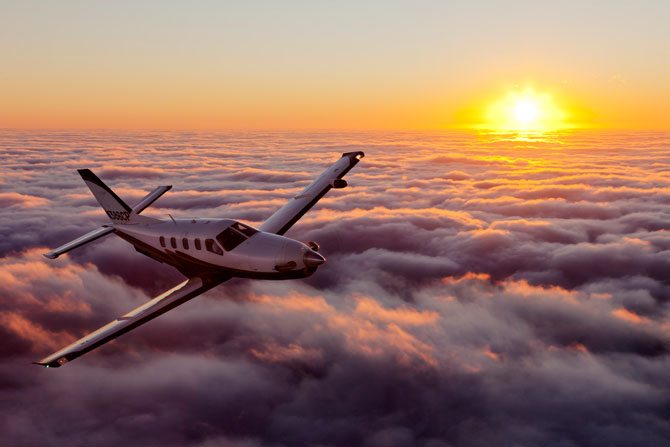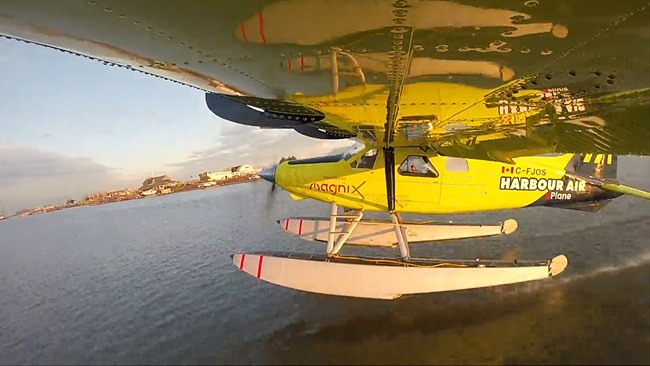Daher-Socata TBM 850: Top-of-the-line T-prop
Speed and economy in a personal-size package
Photography by Mike Fizer and Chris Rose
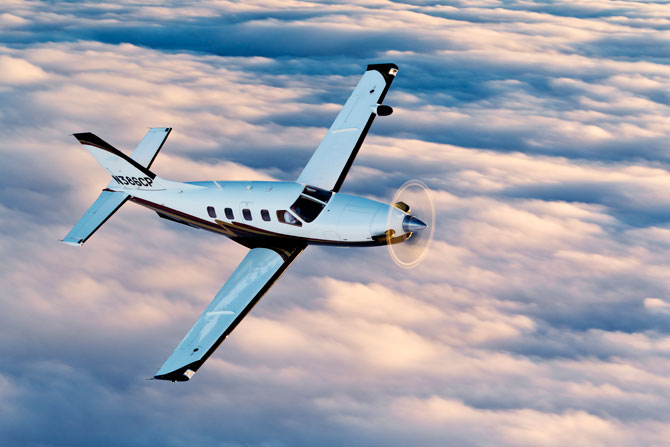
Don’t look now, but Daher-Socata’s TBM series of single-engine turboprops is officially 26 years old. The airplane that began life on engineer Denis LeGrand’s drafting board at Socata’s facility in Tarbes, France, in December 1986, came to fruition under a partnership with Mooney Aircraft Company in the late 1980s, and had its first delivery in 1990 is now considered by many the ultimate personal turboprop. The recent delivery of the six-hundredth TBM—a TBM 850 model featuring Garmin’s G1000 avionics suite—underscores the brand’s enduring popularity.
January 2012
Turbine Pilot Contents
- Going Single: An international flight showcases a TBM 850
- Top-of-the-Line T-Prop: Flying the six-hundredth TBM proves why the brand has staying power
- Transition Troubles: Varying transition altitudes and transition levels present traps for international pilots.
- Flair in the Flare: Tips on how to roll a jet onto the runway in style.
In the early days, Socata outwardly embraced the notion of a single-engine turboprop, touting the advantages of such a design: safety, simplicity, economy, and pilot insurability—all without sacrificing speed or range. But in the late 1980s traditional views held sway. The only acceptable turboprop was one with two engines, and its name was King Air.
“Today we see none of the resistance to the idea of a single-engine turboprop the way we used to. That issue is completely gone among our prospects,” says Michel Adam de Villiers, Daher-Socata’s vice president of sales.
Pratt power
A great deal of this loyalty can he laid at the feet of the engines powering the TBM series. The first TBMs—the TBM 700s—are powered by 1,580-shaft horsepower Pratt & Whitney PT6A-64 engines, derated to 700 shp. Current-production TBM 850s have more powerful, 1,825-shp PT6A-66D engines, derated to 850 shp. These are essentially the same engines used in Piaggio’s Avanti, and the derating yields better hot-and-high performance. It also lets the -66Ds produce those 850 horsepower right up to FL260-280, where maximum cruise speeds can reach 320 to 325 KTAS under optimal temperature conditions.
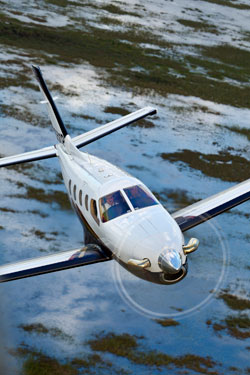 The PT6s used in TBMs do not have full authority digital engine controls (FADECs), so start procedures involve a few simple steps that the pilot must manually perform. However, both the -64s and -66s have torque limiters, so the chances of a ham-fisted pilot’s shoving the power lever past torque limits are minimized. With the -64s, the torque limiter kicks in at 110-percent torque—though it’s never wise to push your luck. It’s best to advance power just short of 100 percent of torque for takeoff, and monitor or adjust it as speed builds during the takeoff run.
The PT6s used in TBMs do not have full authority digital engine controls (FADECs), so start procedures involve a few simple steps that the pilot must manually perform. However, both the -64s and -66s have torque limiters, so the chances of a ham-fisted pilot’s shoving the power lever past torque limits are minimized. With the -64s, the torque limiter kicks in at 110-percent torque—though it’s never wise to push your luck. It’s best to advance power just short of 100 percent of torque for takeoff, and monitor or adjust it as speed builds during the takeoff run.
The TBM 850 was introduced in 2006, and with it came not just the extra 150 horsepower, but a new twist on torque control. For takeoff and landing—using the TO flap defection—automatic torque limiting keeps torque below 110 percent. But once established in the climb you lift the flap switch up and over a detent. This disengages torque limiting, but in exchange you can go all the way to the 121.4 percent torque redline—which gives you the engine’s full, 850 horsepower. Caveat: You are now the torque limiter, so care must be taken not to exceed redline.
Since 1998, TBMs have come with a large entry door that allows easier access to both the cabin and the aft baggage compartment; there’s another, smaller baggage compartment in the nose. When the door extends, a handrail and a set of sturdy stairs do too (bottom). To close the door, a fuselage-mounted push button activates an electric motor that starts the process. An optional pilot door ($89,350) is installed forward of the left wing root and next to the front left seat; of the 40 TBM 850s delivered in 2011, 17 ordered the pilot door. The landing gear (below) can be extended at speeds up to 178 KIAS—the same extension speed as the first notch of flaps.
Garmin glass
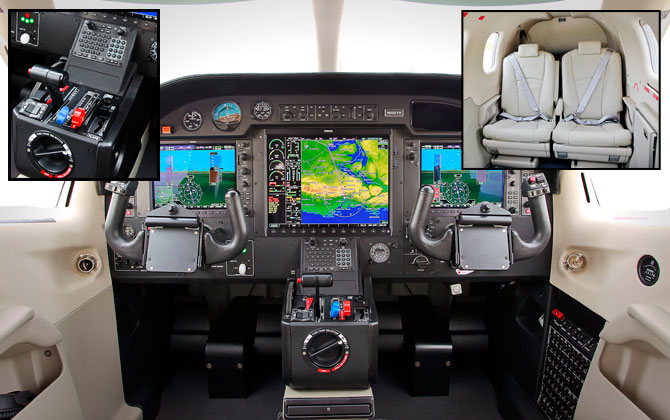
The TBM 850's G1000 (above) features a large 15-inch diagonal multifunction display (MFD) capable of showing a wide range of information. This includes a crew alerting system (CAS) that posts warnings and sounds aural alerts. Visible at the lower left corner of the MFD, in this photo it's giving nine alerts, three of them in red—indicating immediate action:Door open, and a loss of fuel and oil pressure—the engine isn't running and the photographer has the door open. Data entry for the MFD is via a keypad mounted forward of the center console (top left inset). Aft of the power controls is the fuel selector, which automatically switches tanks to prevent fuel imbalances. Four leather seats in a club configuration (above right inset) are standard, although an optional ($9,990) toilet can be installed in place of the left center seat.
 The big news with the TBM 850s built since mid-2007 is the airplane’s Garmin G1000 avionics suite. Before, the panel was built around a combination of Bendix/King’s EFIS 40 attitude and heading displays, plus dual Garmin GNS 530 GPS/navcoms and Honeywell’s IHAS (integrated hazard awareness system) 8000. There were more than a few round gauges, including a vertically stacked set of engine gauges. The G1000 does away with all that. Now, virtually all information is on one or more of the G1000’s two 10-inch PFDs (primary flight display) and its single, 15-inch MFD (multifunction display). This system has all you could ask for: vertical tapes for airspeed and altitude; synthetic vision; real-time wind vectors; multiple bearing pointers; engine gauges; system synoptics; TAWS-B; XM WX datalink weather capability; electronic charts; your choice of moving map displays; and much, much more—all of it front and center.
The big news with the TBM 850s built since mid-2007 is the airplane’s Garmin G1000 avionics suite. Before, the panel was built around a combination of Bendix/King’s EFIS 40 attitude and heading displays, plus dual Garmin GNS 530 GPS/navcoms and Honeywell’s IHAS (integrated hazard awareness system) 8000. There were more than a few round gauges, including a vertically stacked set of engine gauges. The G1000 does away with all that. Now, virtually all information is on one or more of the G1000’s two 10-inch PFDs (primary flight display) and its single, 15-inch MFD (multifunction display). This system has all you could ask for: vertical tapes for airspeed and altitude; synthetic vision; real-time wind vectors; multiple bearing pointers; engine gauges; system synoptics; TAWS-B; XM WX datalink weather capability; electronic charts; your choice of moving map displays; and much, much more—all of it front and center.
The G1000 may look intimidating at first, however, those with some Garmin time will soon come to terms with it. Data entry is via the old turn-and-push rotary knob selection method, or a central keypad above the center pedestal. The “chapters and pages” method of data presentation will make sense to any Garminite, what with the choice of Map, Waypoint, Aux, and Nearest functions and their associated subfunctions. There’s VNAV, of course, as well as Garmin’s glareshield-mounted GMC 710 automatic flight control system (AFCS). The PROC (procedures) button, used for selecting arrivals, approaches, and departures, is right there on the keypad, and so are the transponder and other controls.
Flight plan functions come up on the MFD when you push the FPL button, but with the latest software in the TBM 850 you can do a whale of a lot more than what you may have been accustomed to in, say, a GNS 430 or GNS 530. Airways can be called up, altitude restrictions can be entered for each fix (select VNV on the AFCS and the airplane will then descend so as to make crossing or mandatory altitudes), and climbs can be made with the AFCS using a selected airspeed (press the FLC, or flight level change softkey) or vertical speed (press the VS key).
Delivering SN 600
I was on hand at the Tarbes factory for the ceremony celebrating the six-hundredth TBM. The day after, it was time to saddle up and fly the new airplane (N600YR) back to the United States. With me was one of Daher-Socata’s main ferry pilots, Margrit Waltz.
The first leg took us north to Glasgow (EGPF)—an 800-nm leg that took three hours, 13 minutes. En route, the G1000’s MFD gave the numbers for our recommended cruise power setting at FL280: 301 KTAS burning 56 gph. The next leg was from Glasgow to Keflavik, Iceland (BIKF), another 800-nm leg that saw us doing 300 KTAS. Groundspeed was a healthy 296 knots, thanks to benign (13-knot) headwind components. On we flew into the night, far above an undercast, in smooth conditions, with the northern lights putting on a show.
And the legendarily lousy North Atlantic weather was staying at bay. For the ILS Runway 2 approach to Keflavik, it was winds 120 at 4 knots, with few clouds at 1,800 feet, 3,000 scattered, and 4,200 overcast. Temperatures were even above freezing (4 degrees Celsius) at the surface! But during the descent we encountered moderate mixed icing, a problem remedied by the TBM’s pneumatic deice boots and electrically heated windshield and propeller elements. Also, the engine inlet ice-separator door was opened to divert any ice particles away from entering the engine and potentially damaging the compressor blades. The ice-separator door is also used during ground operations to prevent dirt and other foreign objects from being sucked into the engine. For the ILS, the flap switch was taken out of the “850” detent and into the TO position, gear were extended just before the final approach fix, power was set to produce 100 KIAS, and down the glideslope we went. At 500 feet agl, full flaps were selected and a very acceptable touchdown was made after decelerating out of a threshold speed of 90 knots. Bravo for me!
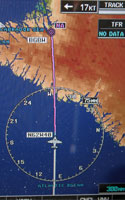 An MFD map shows SN600—N600YR—on its way to Narsarssuaq, Greenland.
An MFD map shows SN600—N600YR—on its way to Narsarssuaq, Greenland.
The leg to the Narsarssuaq, Greenland, airport (BGBW) was just 670 nm, which the ship ate up in two hours, 25 minutes. Once again, we flew at FL280, burned 55 gph, and now saw 297 KTAS in the -50 degree Celsius (ISA -10 degrees at that altitude) outside air temperatures. By the way, it’s easy to set power. For climbs in the 850-horsepower mode a white diamond appears on the torque gauge; move the power lever so as to line up the pointer with the diamond and you have the recommended climb power setting. Similarly, in cruise a white box appears on the torquemeter’s arc. Match the pointer with the low end of the box and presto—you’re at the recommended cruise power setting.
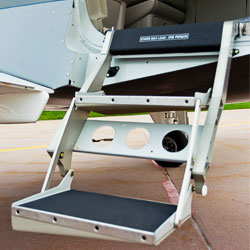 Since 1998, TBMs have come with a large entry door that allows easier access to both the cabin and the aft baggage compartment;there's another, smaller baggage compartment in the nose. When the door extends, a handrail and a set of sturdy stairs do too (above). To close the door, a fuselage-mounted push button activates an electric motor that starts the process. An optional pilot door ($89,350) is installed forward of the left wing root and next to the front left seat;of the 40 TBM 850s delivered in 2011, 17 ordered the pilot door.
Since 1998, TBMs have come with a large entry door that allows easier access to both the cabin and the aft baggage compartment;there's another, smaller baggage compartment in the nose. When the door extends, a handrail and a set of sturdy stairs do too (above). To close the door, a fuselage-mounted push button activates an electric motor that starts the process. An optional pilot door ($89,350) is installed forward of the left wing root and next to the front left seat;of the 40 TBM 850s delivered in 2011, 17 ordered the pilot door.
Talk about more weather anomalies: For the landing at Narsarssuaq skies were clear and winds were light. After a quick turn to gas up, it was off to Sept-Iles (CYZV), Quebec—970 nm and three hours, 50 minutes away. The cruise drill was the same—FL280 and torque slightly below recommended cruise for an average fuel burn of 53 gph for this, the longest of the legs. We landed with 100 gallons of fuel reserves. Not bad at all after nearly four hours en route. Waltz calls the TBM 850 a solid, 5.5-hour airplane. Make that seven hours if you dial back to long-range cruise power, meaning a ballpark cruise speed of 240 KTAS and a fuel burn of 39 gph.
Landings
In all, I got to log 14 hours in this particular crossing. It gave me time to come to terms with the airplane as well as its G1000, and helped underscore why those transitioning from Bonanzas and Cirruses have little trouble learning the ropes—after a pilot training course at SimCom Training Centers, the cost of which is built into the TBM 850’s $3.3 million list price.
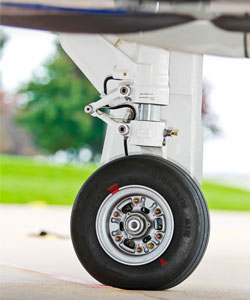 The landing gear can be extended at speeds up to 178KIAS—the same extension speed as the first notch of flaps.
The landing gear can be extended at speeds up to 178KIAS—the same extension speed as the first notch of flaps.
As with all airplanes, landings take some time to master. But it’s not a big deal. I hadn’t flown a TBM 850 in four years, yet I greased two landings—one at Glasgow and the other at Keflavik. The rest involved either excessive floating or a drop-in. Daher-Socata demonstration pilot Wayman Luy explained that it’s often best to plant the airplane rather than go for a smooth, roll-on landing. With any power above flight idle or any excess speed, the airplane will “float like a Mooney, so after the main gear touch down it sometimes helps to intentionally lower the nosewheel to the runway in order to get the wings at a negative angle of attack and kill any lift,” Luy said, adding that the nosegear assembly is extremely strong and up to the task. As for those drop-ins, the airplane’s flaps may be long, have an area of 40 square feet, and thus keep stall speeds low—but the wing can shed lift quickly in an aggressive flare. The airplane doesn’t have trailing-link landing gear, so any firm arrivals can seem firmer when those straight legs absorb the shock of a graceless touchdown.
It’s clear that the TBM 850 is another winner, but one can’t help but wonder if there might be a TBM 900 in the works. Company officials say no, citing the lack of a suitable engine. Besides, any new-airplane debates at Daher-Socata must certainly focus on the NTx—the company’s next offering. This could either be a reborn Grob SPn, a twinjet project that Daher-Socata purchased, or a twin turbine (could be a jet, could be a turboprop) that the company is unwilling to discuss now. In the meantime, the TBM 850 soldiers on as one of the most capable turboprops ever built.
Email the author at [email protected].
